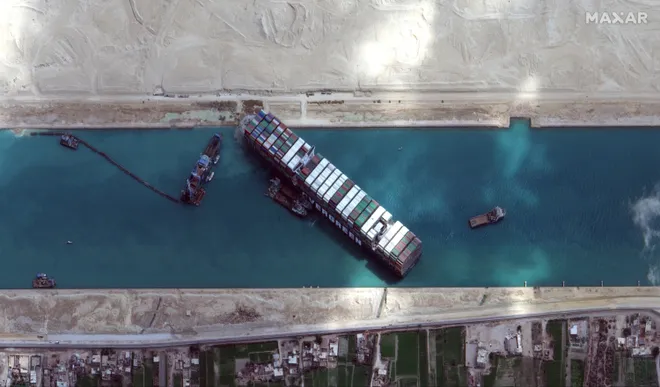Explaining the Suez Canal Blockage
Image taken on March 28, 2021, of the Ever Given being dredged.
April 6, 2021
On March 23, 2021, the 220,000-ton Ever Given ship got stuck while trying to pass through the Suez Canal in Egypt. The problem was exacerbated being that this canal is vital for global trade.
According to the BBC, It has been suspected that unusually high wind speeds were the cause of the blockage. The wind speed had been recorded at 40 knots and there was a sand storm going on at the time. The Suez Canal Authority (SCA) has said human or technical errors were likely also contributing factors. Another contributing factor is the boat’s size. It is about 194 feet wide and, according to History, the canal is 200 to 300 feet wide depending on what part of the canal you are at. Regardless, this doesn’t allow much room for error, and according to Sayed Sheisha of the SCA, the Ever Given had gotten into two other accidents prior to that fateful day. An investigation is currently underway to conclusively determine the cause.
The effects of the blockage are yet to be entirely seen, but about 420 ships were stopped because of the blockage. Considering that roughly 50 ships pass through the canal daily carrying about 10% of global world trade, a blockage of this size is very impactful. Justin Harper of the BBC explained that about $400 million in trade was lost every hour that the Ever Given was blocking the canal because of all the goods that were held up. Ossama Rabei, head of the SCA, told ElBalad News that Egypt could possibly ask for $1 billion in compensation for the physical and financial damages caused by the six-day blockage from whoever the investigation proves guilty.
During those six days, people were working tirelessly to free the ship. According to The New York Times, with the help of the Mashhour, a boat made with the purpose of dredging, 30,000 tons of sand were removed from around the ship. Once the sand was dug up, tug boats were attached to the Ever Given at very specific spots and began pulling. Eventually, the stern of the boat came free and was afloat, but the bow remained stuck. A 400 meter lever had to be imported to help free the bow lodged in the clay of the canal. However, it was still looking like the team would either have to keep digging or begin removing some of the containers held by the ship.
On Sunday, a near miracle happened. There happened to be a supermoon which caused the tides to rise about one and a half feet. This meant that they wouldn’t have to unload the 18,000 containers held by the ship. They had to act quickly before the tides lowered the water level. They got two of the largest tug boats in the area and were then able to free the boat. Had it not been for such a hard working team, along with the luck of the timing of the high tide, the boat might have been lodged for days to come, costing more and more money.
While the impacts were significant, things could have been much worse had the blockage happened at a different time. This has raised debate about the use of ultra-large container vessels. The Panama Canal is even narrower and when it was expanded to accommodate the larger vessels, it cost five billion dollars to do so. According to The New York Times, the size of trade boats has been steadily increasing in recent years. Some suspect that the Suez Canal blockage might cause this trend to stop and therefore prevent similar incidents from happening.












